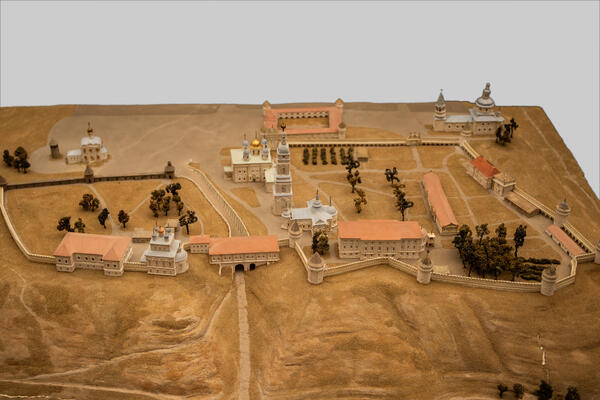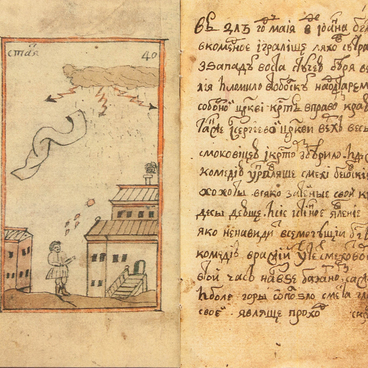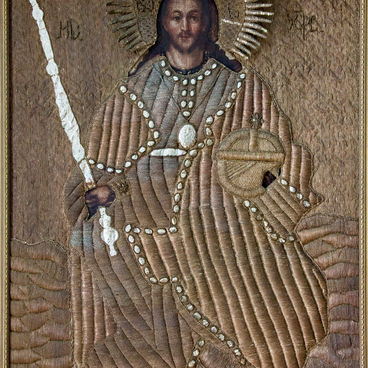The history of the Tobolsk Kremlin begins in 1587, when a group of service people led by the head of the writing department Danila Chulkov laid the foundation for the first wooden ostrog on Troitsky Cape near the confluence of the Tobol river with the Irtysh river. Three years later, Tobolsk received the status of the administrative center of Siberia, and the existing fortress became known as the Kremlin. The creation of the Siberian and Tobolsk diocese in 1620 secured the city’s high status. During this period, the territory of the Kremlin expanded to include two sections — the Voivodeship and Bishop’s court.
At the end of the 17th century, the first stone building in Siberia, the St. Sophia Assumption Cathedral, was built on the territory of the Bishop’s court. At that time, they also put up military defensive structures — walls and towers. At the beginning of the next, 18th century, according to the project of the architect and cartographer Semyon Remezov, Departmental Chambers, Gostiny Dvor, and the Rentereya (the Chamber Treasury) were built in the white-stone Kremlin. Remezov himself drew up drawings of the stone fortifications of the city, calculated the estimate of works, and personally supervised the construction. The architectural ensemble has since changed. The hays and towers constantly changed their appearance, and by the beginning of the 20th century, a significant part of them was completely destroyed.
In the second half of the 20th century, the Moscow Central scientific restoration design workshops became interested in the monuments of stone architecture of the city and in 1952 developed a project for their restoration.
In 1956, an experienced engineer Fyodor Dubrovin began an important work on the study and restoration of the Kremlin objects. Fifteen years later, the walls and towers of the Kremlin were restored, the lost gilding of St. Sophia Cathedral and the facade of Gostiny Dvor were restored, and the Foundation of the Chamber Treasury was strengthened. The Tobolsk Kremlin has regained its ensemble appearance. It was in this period that a model of the Tobolsk Kremlin was made in the Central scientific restoration design workshop model department. This is a visual reconstruction of its architectural ensemble, which shows, among other things, objects that no longer exist: some towers, Voznesenskaya, Troitskaya, and Nikolskaya churches.
At the end of the 17th century, the first stone building in Siberia, the St. Sophia Assumption Cathedral, was built on the territory of the Bishop’s court. At that time, they also put up military defensive structures — walls and towers. At the beginning of the next, 18th century, according to the project of the architect and cartographer Semyon Remezov, Departmental Chambers, Gostiny Dvor, and the Rentereya (the Chamber Treasury) were built in the white-stone Kremlin. Remezov himself drew up drawings of the stone fortifications of the city, calculated the estimate of works, and personally supervised the construction. The architectural ensemble has since changed. The hays and towers constantly changed their appearance, and by the beginning of the 20th century, a significant part of them was completely destroyed.
In the second half of the 20th century, the Moscow Central scientific restoration design workshops became interested in the monuments of stone architecture of the city and in 1952 developed a project for their restoration.
In 1956, an experienced engineer Fyodor Dubrovin began an important work on the study and restoration of the Kremlin objects. Fifteen years later, the walls and towers of the Kremlin were restored, the lost gilding of St. Sophia Cathedral and the facade of Gostiny Dvor were restored, and the Foundation of the Chamber Treasury was strengthened. The Tobolsk Kremlin has regained its ensemble appearance. It was in this period that a model of the Tobolsk Kremlin was made in the Central scientific restoration design workshop model department. This is a visual reconstruction of its architectural ensemble, which shows, among other things, objects that no longer exist: some towers, Voznesenskaya, Troitskaya, and Nikolskaya churches.



